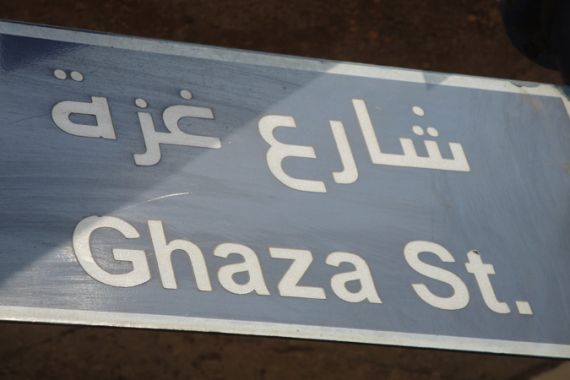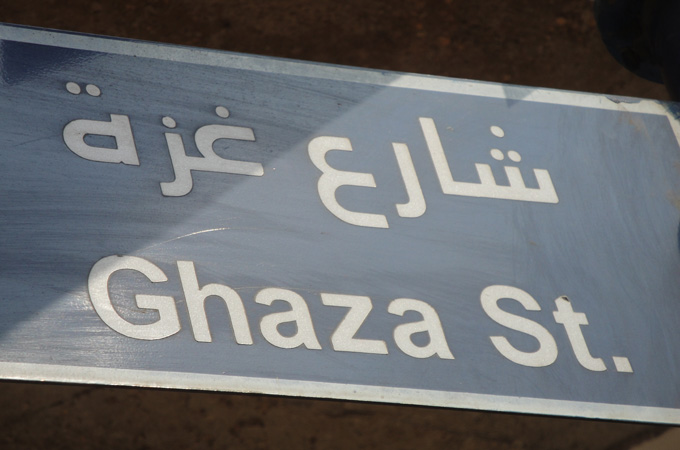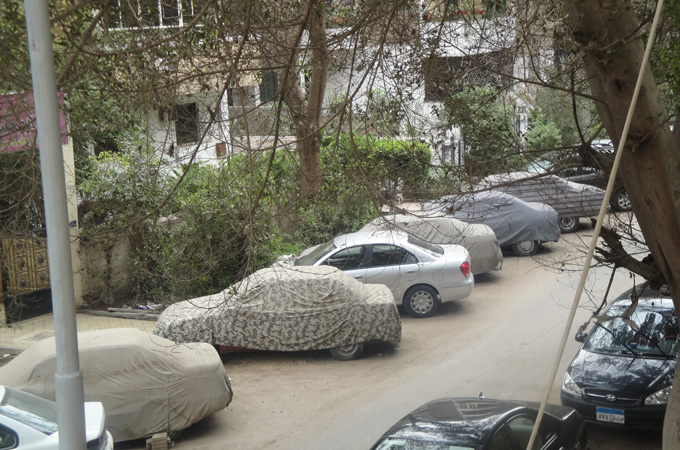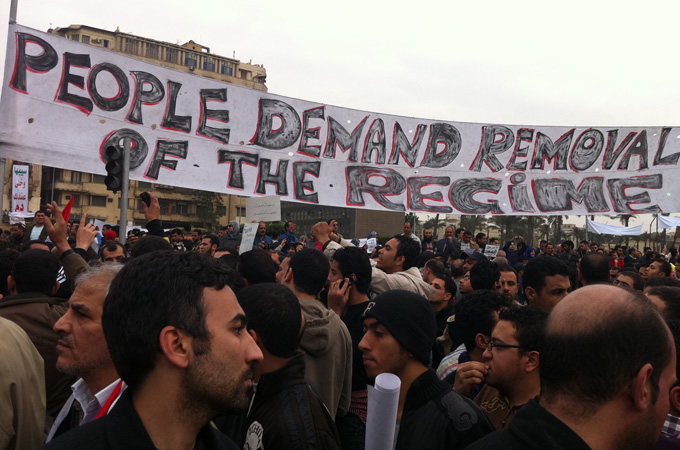The news from Gaza Street, Cairo
The fall of Egypt’s Hosni Mubarak as seen from one Cairo neighbourhood.

 |
| The fall of Hosni Mubarak as seen from Cairo’s Gaza Street [Ayman Nasreldin] |
Al Jazeera’s Nashwa Nasreldin was on her way to Tunisia when news of an uprising in her native Egypt broke. In a series of personal accounts, she tells the story of the revolution that would eventually topple a dictator. The first installment, The news from Gaza Street, introduces us to her family and their take on the unfolding events.
On January 25, 2011, Egyptians were waking up to the first morning of an 18-day uprising that would see the toppling of a dictator. I was sitting on a plane heading not to Cairo, but to Tunisia, the state that had just bid a bitter farewell to its own one-party past.
I was one of many who underestimated the significance of the protest movement that began in my native country that day. I had expected the worst. I worried that because poverty levels and state repression were more acute than in Tunisia, the revolution, if it did take off, would only result in more people being killed, and little or no change.
In Suez and Alexandria events quickly became life-threatening for protesters. Members of my extended family throughout Egypt rushed to send me videos they had filmed of scenes they had never imagined they would see. For those living in the capital, however, things developed more slowly.
Smaller demonstrations were forming in various locations around downtown Cairo and were quickly and violently dispersed by uniformed and plain-clothed police. Still, for my parents in their leafy Gaza Street home, things remained calm and talk of revolution seemed far-fetched.
A haven in Gaza Street
My parents were on holiday in Cairo at the time at our family home in Mohandiseen, an upmarket neighbourhood on the west bank of the Nile. Literally translated as ‘Engineers’, the name Mohandiseen is a reference to its development in the 1950s from agricultural land into a residential suburb for Egypt’s new technocrats.
Government-subsidised land was offered to engineers, including my late grandfather, who built one of the low-rise villas characteristic of the time. Today the area is a trendy yet overcrowded commercial suburb, known for its tree-lined streets, most of which are named after Arab countries, cities and districts.
Gaza Street was shielded from the realities of the capital. Like many Egyptians, my parents were not worried. They brushed off the protests as just another show of public discontent that would ultimately end in beatings and arrests.
I could not help but wonder if their state of denial reflected the view presented by the state media, since the international news I was following reported accounts of foreign journalists being beaten and arrested for simply covering the protests. Egyptians were used to being victims of their security forces, but it was different to hear of foreign journalists being treated this way.
The personal account and accompanying audio file by Jack Shenker from the Guardian newspaper showing his arrest by Egyptian police were quickly shared on social media networks. Soon we were reading articles by other prominent journalists who described their experiences in Egypt as being more frightening than reporting from Lebanon or Gaza.
Revolution re-routed
Even though I had not flown to Egypt, news of Egypt followed me.
As I met the excited revolutionaries in Tunisia, many of them were more interested in passing on their support to Egyptians than in telling me their own stories. Young activists still buzzing with excitement from their revolution urged me to advise Egyptian friends on how best to combat tear gas.
Before long, the media circus that had descended on Tunisia after Zine El Abidine Ben Ali’s departure was quickly filling up the flights from Tunis to Cairo.
In Egypt, the government promptly shut down access to the internet and mobile phones. Some of the more internet-savvy were able to use proxy sites to get online, again with the help of Tunisians who passed on the skills they had learned during their revolution, and from internet activist groups such as Anonymous.
 |
| Gaza Street, the news hub for Nashwa’s updates on Egypt’s revolution [Ayman Nasreldin] |
Others used phone services set up to allow them to record a voice message which would then be converted into text on Twitter. Many actually credit this online blackout as a key factor in mobilising demonstrators.
Without easy access to information, even the politically apathetic headed out onto the streets to see what was happening, or to search for family members who were already out there. So the thousands became hundreds of thousands, and then millions.
Egyptians abroad, including myself, were frantically trying to find ways to contact relatives and friends, searching address books for home phone numbers long abandoned in the era of mobile phones. My parents became my news-gatherers; their updates gave me a sense of how events were being perceived from the confines of our Egyptian home.
A ‘Day of Rage’
On Friday, January 28, hundreds of thousands of Egyptians went out to demonstrate their anger towards the regime. They were met by a much fiercer force backed with live ammunition. From my safe vantage point in the country that had unwittingly provided the spark, I stared at the terrifying scenes of a barrier of fear being broken by a sea of protestors.
As I watched the Egyptian uprising grow in force, I could feel that it had taken on a power of its own regardless of my – or others’ – misgivings. That day state television announced that Hosni Mubarak would make a long awaited public address, the first since the start of the uprising.
In Tunisia, people wondered whether he would have learnt any lessons from Ben Ali’s experiences. Egyptians wondered whether he would make any concessions. On social networks, anger was expressed at his delay in addressing the people.
When he finally appeared on our screens, Twitter users shared snippets of his speech; just seconds after the words were uttered.
I typed as he spoke: “The problems we face … cannot be achieved through violence or chaos”; “our plans are to combat unemployment and provide more educational services, healthcare, housing and many other services”; and “we call on our youth and each Egyptian citizen to work in the public interest of the people … not by setting fire to property.”
There was barely time to digest what was being said as everyone critiqued the president and his speech-writers. He laid his first cards down and announced the dismissal of his entire cabinet, the appointment of a new prime minister, Ahmed Shafiq, and for the first time in the history of his 30-year rule, a vice president, Omar Suleiman.
Safety in numbers
In these early days, before personal safety became the issue on everyone’s minds, the country began to analyse these new promises. As the police disappeared from the streets, unidentified criminals suddenly appeared. The coincidence was not lost on Egyptians; photos were quickly shared on Twitter of police IDs found on some of the criminals after they were caught.
By now there was a noticeable change in my mother’s tone. She informed me, distractedly, of the looted businesses on a nearby shopping promenade and of how they had heard that the thugs had reached the street adjacent to theirs.
Reports aired on Al Jazeera of civilians setting up their own checkpoints to replace the disappearing police force were corroborated by my parents. At night they proudly related to me the scene in Gaza Street where men, young and old, were preparing to protect our homes. It was a scene repeated in almost every neighbourhood. So much so that it inspired my mother to post a poem on Facebook dedicated to the “youth”.
[Translation]
“Hand in hand, our museum you protected … oh youth of Egypt
With sticks and rods, our streets you safeguarded … oh youth of Egypt
Neighbourhood watches, citizen traffic wardens, you joined in … oh youth of Egypt
A thousand greetings from Egyptians, near and far … to the youth of Egypt”
“All the men in our family are spending the nights in the streets,” my mother said, excitedly describing how people would give them make-shift weapons, including sticks, knives and guns. While I worried about automatic weapons in the hands of minors, reports were coming in of escaped prisoners being captured by residents in the affluent neighbourhood of Maadi.
Brave new world
While state television continued to play on the fears of the population, terrifying them with stories of the ongoing “unrest” created by the demonstrations, on Twitter I read of a new world emerging in Tahrir Square, which had by now become one of the centres of the uprising.
It was being described as a utopian micro-state where the people cleaned the roundabout and surrounding roads, which had been turned into a large campsite.
For the first time in my life, I heard young Egyptians speak with pride about their country.
One activist wrote of her newfound sense of ownership of the country. From thousands of miles away I was infected with the same fervour. Clearly I was not the only one.
Solidarity protests in London brought hundreds of Egyptians to their embassy, repeating the chants being used in Egypt. Photos of demonstrations at Egyptian embassies worldwide circulated on Twitter and Facebook and would, in seconds, reach those in Tahrir. It felt as if Egyptians around the world were united for the first time.
But it would not be long before Mubarak made a second address to the Egyptian people that would tip the scales back in his favour.
On the night of January 30, Hosni Mubarak spoke of the sacrifices he had made for the country and its people and recounted his past military accomplishments. He announced that, in response to the demands of the people in the street, he would not run for re-election, but that he would also not leave Egypt – a reference to Ben Ali’s shameful departure.
Mubarak would not flee, he would “die on this soil”.
It was at this point that the hearts of even some of his staunchest opponents began to soften. To them, he had heard their demands and was complying with them. A wave of guilt swept through many Egyptians – how could they treat a war hero who had given his life to them with such disrespect?
The next morning I flew to the UK. When I arrived in London I called my parents who complained of another sleepless night. Gunfire, they said, but no one seemed to be sure who was shooting.
March of a million
The following day had been promoted as a ‘Million Man March’, marking the one week anniversary of the start of the protests. As I watched images on the office television of what looked like hundreds of thousands, if not quite a million, bow down in prayer, I was reminded of the Muslim pilgrimage to Mecca.
 |
| Tahrir Square, the centre of Egypt’s revolution [Sherif Sidky] |
I felt a surge of pride as I heard the national anthem being sung in unison by the swelling crowd. Not being there was becoming tougher by the day.
On the February 2, the internet ban was lifted. While Egyptian bloggers and tweeters were welcomed back into social networking rooms, I was shocked to discover that there were many Egyptians who strongly condemned the actions of their rebellious brothers and sisters.
The arguments that surfaced on my Facebook newsfeeds directed my attention towards what I felt was a frightening development. I snuck around the virtual walls of my friends’ profiles, eavesdropping on heated virtual debates.
My sister-in-law had changed her profile photo to a crossed out photo of Mubarak, which elicited a heartfelt demand from her cousin in Egypt to remove it immediately because, she argued, “Mubarak is our father, just like Egypt is our mother”.
The photo was not removed, and unlike some of the other disagreements I was witnessing, this one ended with a few carefully worded comments. As I scrawled through other discussions, one by one I watched Facebook friends lists go through an early Spring clean.
I could see that it was hard to be logical and to debate politely when everything was so emotionally charged. For while victims were being labelled “martyrs” of the “revolution” in the battlefields of Cairo, fellow Egyptians were placing hefty blame on those who supported them for sending the nation spiralling into a state of chaos.
Videos of protestors being attacked by thugs were circulated on Facebook and Twitter, faster than Egyptian state television presenters could play down the magnitude of the movement.
Celebrities began weighing in on the debate, quick to make their position clear. Some called in to programmes on private Egyptian channels asking for Mubarak to “with all due respect, stand down”.
Others vehemently supported the president and denounced the actions of the “January 25th youth” as they were becoming known, a ploy that in itself would become key in the mounting war of words.
Follow nashwanasreldin on Twitter for updates on the next part of her series on the Egyptian revolution.